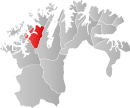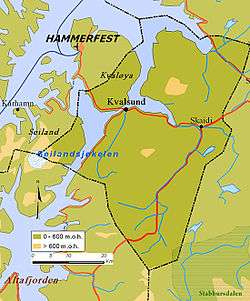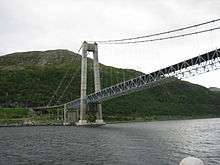Kvalsund
| Kvalsund kommune Fálesnuori gielda Valasnuoran komuuni | |||
|---|---|---|---|
| Municipality | |||
|
| |||
| |||
 Kvalsund within Finnmark | |||
| Coordinates: 70°29′56.3″N 23°58′26.2″E / 70.498972°N 23.973944°ECoordinates: 70°29′56.3″N 23°58′26.2″E / 70.498972°N 23.973944°E | |||
| Country | Norway | ||
| County | Finnmark | ||
| District | Vest-Finnmark | ||
| Administrative centre | Kvalsund | ||
| Government | |||
| • Mayor (2015) | Terje Wikstrøm (Ap) | ||
| Area | |||
| • Total | 1,844.09 km2 (712.01 sq mi) | ||
| • Land | 1,739.28 km2 (671.54 sq mi) | ||
| • Water | 104.81 km2 (40.47 sq mi) | ||
| Area rank | 37 in Norway | ||
| Population (2014) | |||
| • Total |
1,051 ( | ||
| • Rank | 397 in Norway | ||
| • Density | 0.57/km2 (1.5/sq mi) | ||
| • Change (10 years) | -3.8 % | ||
| Demonym(s) | Kvalsundværing[1] | ||
| Time zone | CET (UTC+1) | ||
| • Summer (DST) | CEST (UTC+2) | ||
| ISO 3166 code | NO-2017 | ||
| Official language form | Bokmål | ||
| Website |
www | ||
|
| |||
Kvalsund (Northern Sami: Fálesnuorri and Kven: Valasnuora) is a municipality in Finnmark county, Norway. The administrative centre of the municipality is the village of Kvalsund. Other villages in the municipality include Áisaroaivi, Kokelv, Kvalsund, Oldernes, Oldervik, Revsneshamn, Skaidi.
The Kvalsund Bridge (Kvalsundbrua) is a suspension bridge that crosses the Kvalsundet strait from the mainland to the island of Kvaløya.
In 2015 media said that for 4 years an application has been filed for establishing Norway's largest copper mine - depending on a permit for creating a zone in Repparfjorden for depositing waste from the mine.[2]
Since 2011, the mayor of Kvalsund is Ragnar Olsen, who represents the Labour Party.
General information

The municipality of Kvalsund was established on 1 July 1869 when it was separated from the Hammerfest landdistrikt (the rural municipality surrounding the city of Hammerfest). Initially, Kvalsund had 514 residents. On 1 January 1963, a small area in southern Måsøy (population: 34) was transferred to Kvalsund.[3]
Name
The Old Norse form of the name was Hvalsund. The first element is hvalr which means "whale" and the last element is sund which means "strait" or "sound". The Sámi name also translates to Whale (fáles) Strait (nuorri).[4]
Coat-of-arms
The coat-of-arms is from modern times. They were granted on 27 March 1987. The arms show three silver-colored salmon arranged in a pall on a blue background. The salmon represents fishing in various forms: as a traditional way of living and source of income, as modern fish farming, and as a recreational activity.[5][6]
Churches
The Church of Norway has two parishes (sokn) within the municipality of Kvalsund. It is part of the Hammerfest deanery in the Diocese of Nord-Hålogaland.
| Parish (sokn) | Name | Location | Year built |
|---|---|---|---|
| Kvalsund | Kvalsund Church | Kvalsund | 1936 |
| Sennalandet Chapel | Áisaroaivi | 1961 | |
| Kokelv | Kokelv Church | Kokelv | 1960 |
Government
All municipalities in Norway, including Kvalsund, are responsible for primary education (through 10th grade), outpatient health services, senior citizen services, unemployment and other social services, zoning, economic development, and municipal roads. The municipality is governed by a municipal council of elected representatives, which in turn elect a mayor.
Municipal council
The municipal council (Kommunestyre) of Kvalsund is made up of 15 representatives that are elected to every four years. Currently, the party breakdown is as follows:[7]
| Party Name | Name in Norwegian | Number of representatives | |
|---|---|---|---|
| Labour Party | Arbeiderpartiet | 7 | |
| Conservative Party | Høyre | 1 | |
| Christian Democratic Party | Kristelig Folkeparti | 3 | |
| Socialist Left Party | Sosialistisk Venstreparti | 4 | |
| Total number of members: | 15 | ||
Geography

The municipality is mostly located on the mainland, but parts of the municipality are also located on the islands of Kvaløya and Seiland. The Seilandsjøkelen glacier is partially located in Kvalsund. Lakes in the municipality include Bjørnstadvatnet and Doggejávri.
Settlements
The main village is called Kvalsund in Norwegian and Ráhkkerávju in Sámi. Historically that village was called Finnbyen, a name meaning simply "Coast Sámi settlement". Most villages in the municipality have two names: one in Norwegian and one in Sami. Other villages in the municipality include Skáidi ("meeting-place of rivers" in Sámi); Stállugárgu or Stallogargo ("troll beach"); Neverfjord or Návvuotna; and Kokelv/Guoikejohka. Regarding the latter toponyms, the Neverfjord translates to "tinder fjord" and Návvuotna to "cowshed fjord"; while Kokelv is "boiling river" in Norwegian and Guiokejohka means "rushing river" in Sámi.
Birdlife
The municipality of Kvalsund has several localities that have a rich and varied bird fauna. One of these is Repparfjordbotn with its large colony of Arctic terns and its autumn numbers of goosander.
Climate
| Climate data for Kvalsund | |||||||||||||
|---|---|---|---|---|---|---|---|---|---|---|---|---|---|
| Month | Jan | Feb | Mar | Apr | May | Jun | Jul | Aug | Sep | Oct | Nov | Dec | Year |
| Daily mean °C (°F) | −6.0 (21.2) |
−5.7 (21.7) |
−4.1 (24.6) |
−0.9 (30.4) |
3.5 (38.3) |
8.3 (46.9) |
11.6 (52.9) |
10.8 (51.4) |
6.7 (44.1) |
1.9 (35.4) |
−2.0 (28.4) |
−4.6 (23.7) |
1.6 (34.9) |
| Average precipitation mm (inches) | 65 (2.56) |
56 (2.2) |
52 (2.05) |
46 (1.81) |
40 (1.57) |
47 (1.85) |
52 (2.05) |
58 (2.28) |
69 (2.72) |
85 (3.35) |
74 (2.91) |
76 (2.99) |
720 (28.35) |
| Source: Norwegian Meteorological Institute[8] | |||||||||||||
Culture
Aboriginal culture
Until a few hundred years ago, Coast Sámi culture was completely dominant in Kvalsund. Norwegian and Kven immigration soon made the area multicultural. During Norwegianization much of the traditional culture was lost. Kokelv is the village that has most successfully preserved elements of Sámi culture, and today has a Coast Sámi museum. The gakti of the Kvalsund region is easily recognizable by dots and jags on the collars (for men) and sleeves (for women).
Fægstock
The municipality hosts an annual rock festival known as Fægstock, which takes place in Fægfjord (Sámi: Veaigesvuotna, "twilight fiord").
References
- ↑ "Navn på steder og personer: Innbyggjarnamn" (in Norwegian). Språkrådet. Retrieved 2015-12-01.
- ↑ Ytreberg, Rune (2015-09-12). "Dette er ikke en lek". Dagens Næringsliv. p. 16.
- ↑ Jukvam, Dag (1999). "Historisk oversikt over endringer i kommune- og fylkesinndelingen" (PDF) (in Norwegian). Statistisk sentralbyrå.
- ↑ Rygh, Oluf (1924). Norske gaardnavne: Finmarkens amt (in Norwegian) (18 ed.). Kristiania, Norge: W. C. Fabritius & sønners bogtrikkeri. p. 138.
- ↑ Norske Kommunevåpen (1990). "Nye kommunevåbener i Norden". Retrieved 2008-12-11.
- ↑ "Kommunevåpen". Flags of the World. 28 June 2002. Retrieved 2008-12-11. External link in
|publisher=(help) - ↑ "Table: 04813: Members of the local councils, by party/electoral list at the Municipal Council election (M)" (in Norwegian). Statistics Norway. 2015.
- ↑ "eKlima Web Portal". Norwegian Meteorological Institute.
External links
 Media related to Kvalsund at Wikimedia Commons
Media related to Kvalsund at Wikimedia Commons

